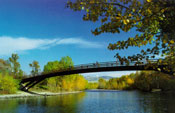
 |
| Julia Davis Park along the Boise River Greenbelt. |
The Boise River basin lies in southwestern Idaho and contains about 4,100 square miles of land. The headwaters of the Boise River originate in the Sawtooth Mountains at elevations in excess of 10,000 feet. It flows in a westerly direction for about 200 miles before emptying into the Snake River near Parma at an elevation of 2,100 feet. Major tributaries to the Boise River include the North Fork Boise River (382 square miles), the South Fork Boise River (1,314 square miles) and Mores Creek (426 square miles). This basin has an average annual runoff of 2,005,000 acre-feet of water.
The Boise River has three major instream impoundments, Anderson Ranch, Arrowrock and Lucky Peak reservoirs, and one large off-stream impoundment, Lake Lowell. The four large reservoirs have a combined storage capacity of 1,143,249 acre-feet of water. Fisheries exist at Lake Lowell, Lucky Peak, Arrowrock, Anderson Ranch, and Little Camas reservoirs. The Lake Lowell fishery consists primarily of largemouth bass, smallmouth bass, yellow perch, black crappie, bullhead, bluegill, and channel catfish. Lucky Peak and Anderson Ranch reservoirs provide "two-story" fisheries with smallmouth bass occupying the warm, inshore waters and rainbow trout and kokanee dominating the cold, mid-water fishery. The rainbow trout fishery in these reservoirs depends heavily on stocked catchable or fingerling size fish. Little Camas and Arrowrock reservoirs are stocked rainbow trout as catchables and/or fingerlings. Neither of these two reservoirs has a conservation pool, and both have a history of total water evacuation. Good spawning conditions in tributary streams provide a continuous supply of kokanee in Anderson Ranch Reservoir, but maintenance stocking is required in Lucky Peak and Arrowrock reservoirs.
Because of the wide range in elevations, geographic features, and water uses, the Boise River has a great variety of habitat types and fish species. The drainage includes the major population center in the state, has over 250,000 acres of irrigated cropland, and some of Idaho's earliest mining, logging, and hydroelectric developments.
From the mouth of the Boise River upstream to Star, low summer flows and poor water quality limit fishery production. This section of river supports a fair fishery for largemouth bass, smallmouth bass, and channel catfish. From Star upstream to Lucky Peak Dam, the river changes from a warmwater to a coldwater fishery. Mountain whitefish make up the bulk of the game fish biomass, with hatchery-reared rainbow trout, wild rainbow trout, and fingerling brown trout plants supporting the bulk of the fishing pressure. Upstream from Lucky Peak and Arrowrock reservoirs, rivers and streams contain excellent populations of wild rainbow trout, mountain whitefish, and bull trout. Brook trout, redband trout, and cutthroat trout occur in some tributary streams.
Alpine lakes within the Boise River drainage provide anglers with a variety of fishing opportunity. Rainbow, cutthroat, and brook trout are abundant with lesser numbers of golden trout. There are 224 alpine lakes in the Boise drainage. Most of these lakes are too small to support a fishery.